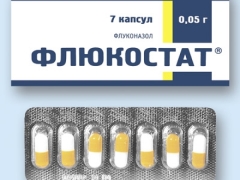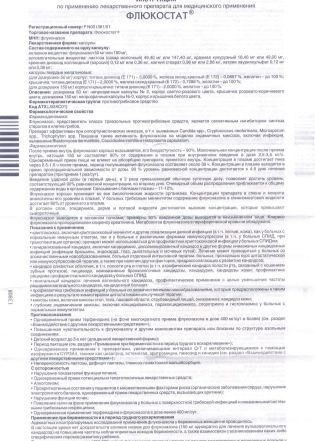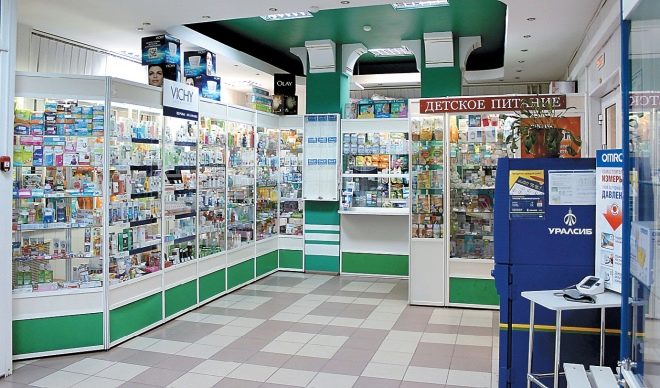Flucostat for children: instructions for use
Fluconazole preparations are very popular, they are designed to combat various fungal infections, including candidiasis in childhood. One of these tools is Flucostat. It has shown itself well in clinical practice and rarely causes side effects.
Release form and composition
"Flukostat" is produced by the Russian company Pharmstandard-Leksredstva in two forms: capsules and injection solution. The main ingredient of drugs, through which the tool acts on fungi, is fluconazole.
Different forms of "Flukostat" have their own characteristics:
- Capsules that contain 50 mg of fluconazolePacked in boxes of 7 pieces. They have size number 2, an opaque pink-brown shell and white contents. Additional components of such "Flucostat" are gelatin, sodium lauryl sulfate, corn starch, acetic acid, milk sugar, aerosil, and some other substances.
- Capsules containing 150 mg of fluconazolesold for 1 piece. They are distinguished by an opaque white gelatinous shell and size number 0, and inside such a capsule is also a white powder. Auxiliary substances in them are the same as in capsules with a lower dosage.
- Injectable form presented in glass vials containing 50 ml of clear solution without any shade. In one package is one bottle. It contains 100 mg of fluconazole. In each milliliter of the solution its amount is 2 mg. The main ingredient is water for injection and sodium chloride.
Operating principle
"Flucostat" is a group of antifungal drugs, because the main component of the capsules and the solution has a selective effect on the cells of fungi. Fluconazole affects pathogenic fungi (due to inhibition of sterol synthesis). It effectively destroys candida, cryptococcus, histoplasma, ringworm pathogens and some other fungi.
Indications
Most often, Flucostat is prescribed for candidiasis. The medicine is prescribed both in case of Candida infection of a certain area (for example, in case of stomatitis or candidiasis of the esophagus), and in case of generalized infection.
The use of this medication for the prevention of candidiasis is equally in demand, which is important for patients with weakened immunity, for example, after transplantation or in the treatment of a malignant tumor. In addition, Flucostat is prescribed for different types of cryptococcosis, for mycoses of the skin and for fungal diseases, which are called endemic (for histoplasmosis, sporotrichosis, etc.).
From what age is prescribed?
The instructions for use indicate that the injection "Flukostat" allowed for children of any age, including infants. Capsules are used to treat patients older than 3 years.
Contraindications
The drug is not prescribed if the child has hypersensitivity to fluconazole or one of the auxiliary ingredients. For children with heart disease, kidney problems or other serious pathologies, Flucostat is given with caution.
Side effects
The digestive system of a child may respond to Flucostat with a feeling of nausea, flatulence, abdominal pain, diarrhea, or even abnormal liver function. In addition, sometimes with the treatment of such a drug appear dizziness or headaches.In rare cases, the drug provokes an allergic reaction (usually in the form of a skin rash), ECG changes and blood tests.
How to give?
The Flucostat solution is used for intravenous drip injections, and the drug in capsules is given to the child to be swallowed (not biting) and washed down with water. The frequency of use of the drug (any form) - once a day. The duration of treatment is determined by the doctor - depending on the diagnosis and response to therapy.
A single dose (it is also a daily dose) is also influenced by the disease in which Flucostat is prescribed, as well as the patient's body weight. If oral candidiasis is found in a child, its weight in kilograms is multiplied by 3 — this is how fluconazole dosage is obtained in milligrams. On the first day, it is often doubled so that the concentration of the drug in the blood quickly becomes maximum.
If the disease has spread (candidiasis has become generalized) or a child has a cryptococcal infection, the dosage will be from 6 to 12 mg per kilogram of patient weight. If the goal is prophylactic (with a decrease in immunity), the dose of fluconazole is from 3 mg / kg to 12 mg / kg.
If the doctor prescribed "Flucostat" injections, then the contents of the vial can be diluted with glucose solution, isotonic solution and other means that are used for drip infusions. It is required to enter medicine slowly.
The dosage of "Flucostat" in injections is also determined by the weight of the little patient and the type of disease. When prescribing a medication to a newborn, the frequency of injections changes, since in the first 4 weeks of life, the excretion of the drug is delayed. At 1-2 weeks of life, Flucostat is administered every 72 hours, at 3-4, every 48 hours.
Overdose and drug interactions
Too high a dose of “Flucostat” in any form can cause changes in the patient’s behavior and cause hallucinations. The first aid in overdosing should be gastric lavage, and then (if necessary) the doctor will prescribe a symptomatic treatment.
As for the compatibility of Flucostat with other drugs, the list of drugs that should not be prescribed with this medicine can be seen in the abstract. It includes hypoglycemic agents, warfarin, rifampicin, zidovudine and other drugs.
Terms of sale and storage
If you need to buy "Flucostat" in capsules, then presenting a prescription is not required, and the solution for injection refers to drugs that are sold only by prescription. The average price of a package of seven capsules of 50 mg is 320 rubles. The shelf life of the capsules is 2 years, the solution for infusions is 3 years.
Keep the medicine in capsules at home should be at a temperature of 15-25 degrees, putting it in a place where it will be hidden from small children.
Reviews
Many mothers who give feedback about Flukostat on the Internet call such a drug effective against candida of different localization and note a rare manifestation of side effects. A single medication is considered a plus, and the disadvantages include uncomfortable dosage forms for children, because Flucostat is not produced as a suspension or syrup. Some parents call the price of the drug overpriced (they choose cheaper counterparts), and the effect of treatment is sometimes weak.
Analogs
If it is required to replace “Flucostat” with an analog, then any of the fluconazole preparations will be suitable. This, for example, "Mikosist", "Fluconazole"," Diflazon ","Diflucan, “Forkan” or “Flucor”. Almost all of these drugs are solid and injectable forms (the most common capsules). Only "Diflucan" is additionally produced in the form of a powder, from which an orange-flavored slurry is made. This tool is often used for candidiasis in infants and children 1–3 years old.
Other drugs that provide antifungal effects can also be used instead of Flucostat. Among them "Candide», «Nystatin"," Candibene "," Itrazol ","Clotrimazole», «PimafucinAnd other means.
However, the above drugs in the composition have different active ingredients, so there are certain limitations (including age), so the choice of such analogues should be made with your doctor.
How to treat fungal infections in children, see the following video.






















